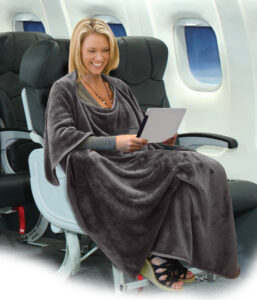
Travel blankets can help with the special comfort issues that come with flying, or they can make the situation worse if they are not picked properly. Good blankets are necessary for comfortable travel due to long flights, and varying cabin temperatures, along with claustrophobic sitting, particularly on nighttime flights across continents. But when choosing a travel blanket for plane, eager passengers usually make avoidable blunders that they only realize after they’ve boarded and it’s too late to fix. These mistakes lead to carrying heavy bags, insufficient warmth, or blankets that airline employees ask you to put away. Avoiding uncomfortable situations that turn useful items into bothersome burdens is made easier by being aware of frequent hazards. Making wise decisions guarantees comfort during flights without adding to the already stressful travel days. Let’s look at some crucial errors that hinder the best possible experience with airplane blankets.
1.Ignoring Airline Size Restrictions Creates Gate Problems
Passengers purchase blankets without being aware of the airline carry-on policies only to realize at the security check or boarding that oversized items are forbidden and should be sent to the gate. There are even compressed blankets that are bigger than what is carried by individuals and therefore individuals must make difficult decisions whether to leave them or risk the unpleasant baggage charges. The various airlines have differing size limits, and the international flights are often subjected to more restrictions than domestic. Checking the size of compressed blankets against the airline standards before buying will help you prevent tense confrontations on the gate and ensure that the blankets arrive with you and not disappear into the cargo space. Current dimension requirements can be found by downloading airline applications or visiting official websites, as policies are subject to change without prior notice to the general public.
2.Choosing Bulky Materials Defeats Portability Purpose
It makes sense to choose large, heavy blankets for warmth, but doing so makes airport navigation, security checks, and the limited storage space aboard airplanes impossible. Uncomfortable circumstances and perhaps confrontations arise when bulky fleece or quilted blankets take up too much overhead bin space that other travelers require. Airport treks are taxing before flights even start since heavy things weigh down carry-ons that are already filled with necessities. With the use of cutting-edge technologies that effectively trap warmth in lightweight packages, modern technical fabrics offer superior insulation without adding bulk. Putting an emphasis on small, light solutions made especially for travel guarantees sufficient warmth without wasting valuable space or adding extra weight during the logistics of the trip.
3.Overlooking Washing Practicality During Extended Trips
It is easy to forget that in the course of long flights, airplane blankets are exposed to questionable surfaces, such as tray tables, seats, and airport floors, along with they collect germs that require regular cleaning. Coming back after weeks without going to the laundry, a purchase of blankets with complicated washing needs leads to problems. When fine fabrics that need professional washing prove to be impossible, travelers are compelled to work with increasingly dirty blankets or abandon them altogether. The hygienic standards are supported by quick-drying and machine-washable solutions, which do not take much time or special equipment. Blankets painted with resistant surfaces will have higher chances of withering spills which cannot be avoided during turbulent beverage services. Instead of becoming unpleasant obligations that passengers grudgingly endure, taking washing logistics into account before making a purchase guarantees that blankets stay fresh and functional for the duration of a trip.
4.Selecting Wrong Fabrics Causes Temperature Discomfort
The extremes of temperature in airplane cabins—from stifling warmth to freezing blasts of air conditioning—call for blankets with a variety of temperature-regulating properties that many materials can not offer. Light textiles provide insufficient coverage against strong air conditioning, whereas heavy fleece causes overheating due to the lowering of cabins or during the entries of hot weather. Moisture gets trapped in the non-breathable materials and therefore makes long flights uncomfortable when there is limited movement. The ability to have comfort at various temperatures is achieved by choosing fabrics that balance breathability and insulation like technical blends or microfiber. Layering is also to be considered; best pocket blanket that can be easily put over clothing provide a chance of adjusting the temperature during flights when various climatic conditions and cabin conditions are encountered.
Conclusion
By avoiding these typical blunders, travel blankets are guaranteed to improve rather than complicate fly travel. While selecting the right materials strikes a compromise between portability and warmth, adhering to airline size regulations avoids gate issues. Choosing custom printed protein shaker manages temperature changes, and keeping cleaning in mind keeps one hygienic over long trips. Value is maximized by giving priority to versatile designs, which justify valuable luggage space through a variety of functions throughout excursions.
